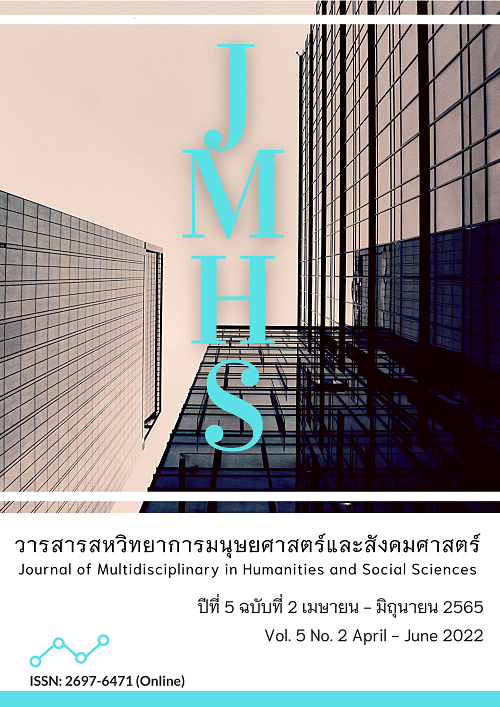Factors Influencing Household Debt Burden During the COVID-19 Situation of Farmers in Sakaeprong Sub-district, Buriram Province
Main Article Content
Abstract
The objectives of this research article were 1) to study factors influencing farmers' household debt burdens and 2) to suggest guidelines for promoting financial discipline to solve the problems of household debt burdens of farmers. This research is mixed research. The sample group used in this research was the population in each farmer's household in Sakaeprong Sub-district, Mueang Buriram District. There were 292 people. Data collection was divided into 2 phases: 1) the use of questionnaires, using a simple sampling method, and quantitative data analysis, the statistics used to analyze the data were frequency, percentage, mean, standard deviation, and multiple regression, and 2) group discussion, with 6 people selected with purposive sampling and using qualitative data analysis. The results revealed that 1) farmers are burdened with household debt expenses each month of 10,001-15,000 baht. It is a debt for consumption. There was borrowing from credit sources in the system. The average duration is less than 1 year, and there is a tendency for the household debt burden in the situation during COVID-19 to increase. The economic factor was the factor that had the greatest influence on farmers' household debt burden. It was statistically significant at the 0.05 level, and 2) there should promote financial discipline by organizing training, seminars, campaigns, and organizing projects to be concrete for people in the community to see the benefits of financial discipline in various ways including knowing how to assess their own financial situation, allocating savings and caution in spending or incurring debt.
Article Details

This work is licensed under a Creative Commons Attribution-NonCommercial-NoDerivatives 4.0 International License.
Views and opinions appearing in the Journal it is the responsibility of the author of the article, and does not constitute the view and responsibility of the editorial team.
References
กวิน มุสิกา, สุชนนี เมธิโยธิน และ บรรพต วิรุณราช. (2562). แนวทางการบริหารหนี้สินเกษตรกรไทย. วารสารสันติศึกษาปริทรรศน์ มจร, 7(1), 111-125.
จิราวรรณ ทองประจวบโชค, วิจิตรา ศรีสอน, สัณฐาน ชยนนท์ และ สุระสิทธิ์ ทิพรัตน์. (2565). ผลกระทบที่เกิดขึ้นกับเกษตรกรประเภทการประมงน้ำจืด จากการแพร่ระบาดของโรคโควิด-19 ในพื้นที่จังหวัดอ่างทอง. วารสารรัฐศาสตร์รอบรู้และสหวิทยาการ, 4(2), 19-30.
ชนาภิวัฒน์ ขันทะ และ สุภาค์พรรณ ตั้งตรงไพโรจน์. (2564). หนี้ครัวเรือนไทยกับแนวทางแก้ไขให้ยั่งยืน. วารสารศิลปศาสตร์และวิทยาการจัดการ มหาวิทยาลัยเกษตรศาสตร์, 8(1), 131-145.
ธนาคารแห่งประเทศไทย. (2562). วินัยทางการเงินของครัวเรือนไทยและบทบาทของ ธปท. ในการแก้ปัญหาหนี้ครัวเรือน. สืบค้นเมื่อ 27 พฤศจิกายน 2564, จาก https://www.bot.or.th/thai/monetarypolicy/monetpolicycomittee/mpr/box_mpr/box_2_3_mpr_th_mar19.pdf
ธนาคารแห่งประเทศไทย. (2565). หนี้ครัวเรือน: ปัญหาที่ทุกคนต้องร่วมด้วยช่วยกันแก้. สืบค้นเมื่อ 18 มกราคม 2565,จาก https://www.bot.or.th/Thai/ResearchAndPublications/articles/Pages/Article_18Jan2022-2.aspx
ปัณภ์ปวีณ รณรงค์นุรักษ์. (2558). ปัจจัยที่ส่งผลต่อหนี้สินของเกษตรกรผู้ปลูกอ้อย ข้าว และมันสำปะหลัง: กรณีศึกษาเกษตรกรในเขตพื้นที่จังหวัดกาญจนบุรี และเพชรบุรี(วิทยานิพนธ์วิทยาศาสตรมหาบัณฑิต). มหาวิทยาลัยธรรมศาสตร์.
ลลิตา บุดดา. (2559). หนี้ภาคครัวเรือนกับวัฏจักรธุรกิจไทย(การค้นคว้าอิสระ หลักสูตรเศรษฐศาสตรมหาบัณฑิต). มหาวิทยาลัยธรรมศาสตร์.
วิรไท สันติประภพ. (2564). ทางออกจากกับดักหนี้ครัวเรือน. สืบค้นเมื่อ 27 พฤศจิกายน 2564, จาก https://thaipublica.org/2021/04/veerathai-48-2/
วิษณุ อรรถวานิช, โสมรัศมิ์ จันทรัตน์, จิรัฐ เจนพึ่งพรม, ภูมิสิทธิ์ มหาสุวีระชัย และ กรรณิการ์ ธรรมพานิชวงค์. (2562). ฟาร์ม เกษตรกร และเกษตรกรรม: มุมมองผ่านข้อมูลและข้อมูลเชิงลึกเกี่ยวกับพฤติกรรม. สืบค้นเมื่อ 28 พฤศจิกายน 2564, จาก https://www.pier.or.th/files/dp/pier_dp_122.pdf
ศิรินภา โภคาพานิชย์ และ สัญญา เคณาภูมิ. (2560). ปัจจัยที่ส่งผลต่อภาระหนี้สินของเกษตรกรอำเภอท่าบ่อ จังหวัดหนองคาย. วารสารสันติศึกษาปริทรรศน์ มจร, 5(ฉบับพิเศษ), 192-201.
ศูนย์วิจัยกสิกรไทย. (2564). หนี้ครัวเรือน 2564 แนวโน้มสูงต่อเนื่อง คาด...ขยายตัวในกรอบ 89-91% ต่อ GDP. สืบค้นเมื่อ 27 พฤศจิกายน 2564, จาก https://kasikornresearch.com/th/analysis/k-social-media/pages/debt-fb-05-04-2021.aspx
สุริยะ หาญพิชัย. (2563). หนี้สินครัวเรือนเกษตรกรไทย: สถานภาพความรู้ปัจจุบันและข้อสังเกตบางประการ. วารสารการพัฒนาการเรียนรู้ศาสตร์สมัยใหม่, 5(2), 191-213.
สุริยะ หาญพิชัย, เฉลิมพล จตุพร และ วสุ สุวรรณวิหค. (2563). ปัจจัยที่ส่งผลต่อหนี้สินครัวเรือนเกษตรกรในจังหวัดลพบุรี. วารสารการพัฒนาการเรียนรู้ศาสตร์สมัยใหม่. 5(5), 309-320.
โสมรัศมิ์ จันทรัตน์, อัจจนา ล่ำซำ, กฤษฎ์เลิศ สัมพันธารักษ์, และ ภูมิใจ ตั้งสวัสดิรัตน์. (2560). X-RAY พฤติกรรมการกู้ของคนไทยผ่าน BIG DATA ของเครดิตบูโร. สืบค้นเมื่อ 27 พฤศจิกายน 2564, จาก https://www.pier.or.th/abridged/2017/14/
โสมรัศมิ์ จันทรัตน์, อัจจนา ล่ำซำ, ลัทธพร รัตนวรารักษ์, ชนกานต์ ฤทธินนท์, ณรงค์ฤทธิ์ อดุลย์ ฐานานุศักดิ์ และ บุญธิดา เสงี่ยมเนตร. (2563). ครัวเรือนเกษตรไทยในวิกฤติโควิด-19. สืบค้นเมื่อ 27 พฤศจิกายน 2564, จาก https://www.pier.or.th/abridged/2020/11/
สำนักงานเศรษฐกิจการเกษตร. (2564). จำนวนเกษตรกรที่ขึ้นทะเบียน. สืบค้นเมื่อ 27 พฤศจิกายน 2564, จาก http://farmerone.org:9502/analytics/saw.dll?portal
เสาวณี จันทะพงษ์, ประภัสสร เพ็งน้อย และ สุพิชา พันธเสน. (2564). ภารกิจแก้หนี้ประชาชน: เพื่อบรรเทาผลกระทบจากโควิด-19 สร้างความเป็นธรรม และลดความเหลื่อมล้ำ (ตอน 1). สืบค้นเมื่อ 28 พฤศจิกายน 2564, จาก https://www.bot.or.th/ThaiResearchAndPublications/articles/Pages/Article_3Aug2021.aspx
Nunnally, J. C. (1978). Psychometric Theory. New York: McGraw-Hill.
Yamane, T. (1973). Statistics: An Introductory Analysis. (3rd ed.). New York: Harper and Row.


